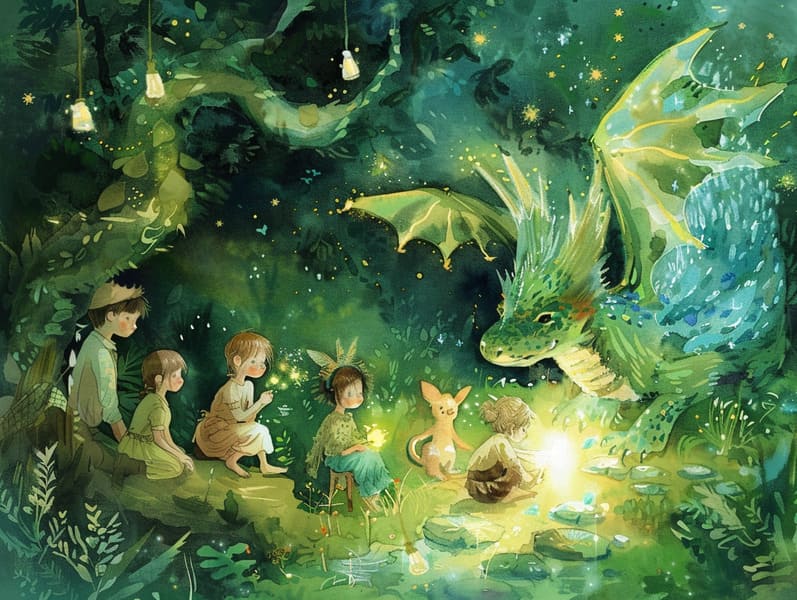The Beginning of Famous Fairy Tales and the Unending Radiance.
The Beginning of Famous Fairy Tales and the Unending Radiance.
Blog Article

Short fairy tales have old origins. These tales have been transmitted from one generation to the next millennia before they were ever inscribed. They were born from a variety of societies, including Indigenous traditions. They were initially disseminated among elders, often carrying themes and messages related to the societal norms and beliefs of the time.
The Grimm brothers, Jacob and Wilhelm (the Grimm brothers), were among the first to gather and publish many of these beloved narratives. Their published works, "Grimm's Story Collection," included classics like "The Little Glass Slipper," "Hansel and Grethel," and "Little Snow White," which have since become mainstays in the world of children's fairy tales. Similarly, Hans Andersen's imaginative stories, such as "The Little Mermaid," and "The Ugly Duckling," have won hearts worldwide, securing their place in the pantheon of classic fairy tales.
Despite their age, fairy tales remain as pertinent as ever, especially as children's bedtime stories. These delightful tales are now available in numerous formats, including gorgeously illustrated books, captivating animations, and online storybooks.
Their lasting appeal can be traced to several captivating elements:
Crucial Morals: Old fairy tales often provide important moral lessons. Fairy tales like "The Tale of the Boy Who Cried Wolf" teach the importance of sincerity, while "The Story of the Tortoise and the Hare" underline the qualities of persistence and humbleness. These tales offer kids clear distinctions between correct and incorrect, building their moral compass in a kind yet meaningful way.
Compassion and Insight: Traditional fairy tales frequently include personalities facing problems and hurdles, inspiring listeners to sympathize with their struggles and back their triumphs. For instance, "The Tale of Beauty and the Beast" emphasizes the virtue of seeing inner beauty to comprehend the real person of a person, enhancing tenderness and awareness.
Cultural Comprehension: Many ancient fairy tales are imbued with the cultural contexts from which they grew. Learning from these tales can provide intriguing perspectives into different beliefs, fostering a sense of cultural understanding and understanding.
Creativity and Imagination: The fanciful elements in timeless fairy tales—enchanted objects—invigorate children’s creative minds. These tales take readers to magical realms, inspiring inventive dreams and a sense of excitement that continues a lifetime.
Timeless fairy tales are not only captivating but also edifying. They serve as fantastical tools in fostering various cognitive and affective skills in children. When timeless fairy tales are told out loud, they nurture verbal development by offering new language items and detailed sentence structures. This practice also nurtures listening abilities and focus, as young readers listen intently, eager to see what happens next.
Furthermore, discussing the themes and characters of timeless fairy tales can improve cognitive skills and thought processes. Young readers are educated to find patterns, guess what will happen, and catch on to cause and effect. These deliberations also ease young ones verbalize their thoughts and feelings, promoting their emotional intelligence.
In today’s high-tech era, the availability of digital storybooks has made these fairy tales more acquirable than ever. Web platforms and web apps provide wide arrays of traditional fairy tales that can be looked at or heard anytime, anywhere. Fairy tales recited are particularly popular, offering an engaging way for young ones to engage with these charming tales. Read-aloud books and read-out-loud videos carry characters and settings to life, often accompanied by mesmerizing sound effects and tunes that raise the tale experience.
The timeless appeal of ancient fairy tales lies in their ability to evolve to present days while preserving their underlying messages. Contemporary revisions of these narratives often bring in more multicultural protagonists and modern settings, making them accessible to today’s audience. However, the fundamental themes of valor, empathy, and truth remain unchanged, continuing to strike a chord with young readers of all ages.
Ancient fairy tales also offer a sense of assurance and comprehensibility. They yield a systematic narrative with a plain beginning, middle, and end, often closing with the ending of conflicts and the triumph of goodness over badness. This regularity can be placating for young readers, granting a sense of stability in an inconstant world.
Timeless fairy tales continue to captivate and inform new generations, maintaining their appeal and applicability in modern society. As bedtime stories for kids, they render accessible a perfect blend of fantasy and learning, cultivating moral values, empathy, and creativity. The accessibility of web-based fairy tales and the in demand status of fairy tales voiced secure that these ancient fairy tales remain attainable to new generations.
By keeping and telling these stories, we continue to celebrate the rich tapestry of creativity and cultural heritage. Whether you are reading a colorful picture book, seeing a web collection, or playing an sound book, the grandeur of children's fairy tales is always within reach. These narratives illustrate of the unchanging presence of tales and its ability to tie us across centuries and lands.
No matter if you are delving into a gorgeously illustrated book, seeing a internet collection, or website listening through an spoken story, the radiance of famous fairy tales is always within reach.
These narratives show us of the perpetual impact of storytelling and its ability to tie us across centuries and lands, casting a charm that charms and informs alike.